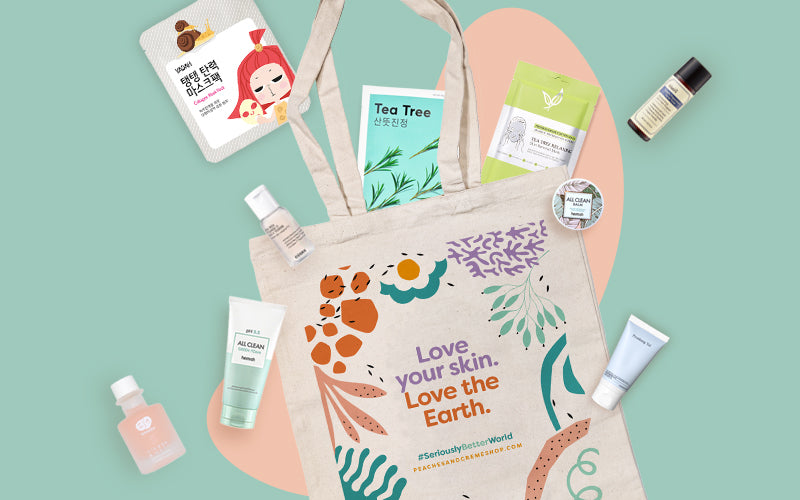Skincare 101: A Beginner’s Guide to Face Masks
Your skin is going to need extra love and attention every once in a while, especially during winter or long flights. When this happens, who you gonna call? Skincare face masks!
Masks contain high concentrations of active ingredients—which make them the perfect SOS for skin troubles. It's important to choose a mask based on your skin's needs but we understand that it can get confusing since there are many, many to choose from.
To get you started, read this guide on the different types, benefits, and uses of skincare masks.

Popular Types of Face Masks
The world of face masks is vast and wide, especially with how consistent Korean skincare brands are at innovating. At this point, no matter what your skin type or concern is, you are guaranteed to find a mask that can help you gain glowing skin.
Let's talk about the most popular masks today so you can start picking out which ones are the best fit for you.
1. Sheet Masks

Cotton Sheet Masks
Sheet masks are the most known and beginner-friendly of the bunch. They are masks soaked in ampoules, serums, or essences—delivering a boost in hydration and a kick of actives to your skin. A sheet mask can give you visible results within minutes which is why it’s a go-to for whenever your skin needs an instant pick-me-up. In addition, this mask is great year-round for every skin type as long as you choose the right ingredients for your skin.
🍑 Don’t throw away the packet after applying your sheet mask! You can use the excess serum on your neck, elbows, and other body parts.
Hydrogel Masks

If you've been on the skincare side of the internet recently, then you've probably heard of hydrogel masks and how much people are absolutely loving them right now.
A hydrogel mask is a type of sheet mask made of absorbent gel that allows it to deliver a hefty dose of actives, vitamins, and hydration to your skin—more than your regular cotton sheet masks. It's great for whenever your skin feels dry or stressed, but this mask can be your skin's savior during the cold seasons of fall and winter since it hydrates and nourishes your skin to the fullest.
If you're looking for a step up from what cotton sheet masks deliver, then we recommend trying a hydrogel mask—it's fun and easy to use!
Popular today: COLLAGEN HYDROGEL MASKS
Collagen is a structural protein found in our skin, bones, and muscles. It is what we need to thank for elastic, soft, and firm skin. As we age, our body produces less and less of this protein; this is why using collagen masks have been a staple in well-aging skincare.
Collagen masks are touted for giving you soft, youthful skin; they visibly plump up fine lines and wrinkles. They have taken the skincare world by storm—and its most popular form are collagen hydrogel masks. They are often used as overnight masks but, if your skin cannot tolerate that much or if it’s too inconvenient, you can shorten that to 3 to 4 hours, 45 minutes, or until it becomes transparent. Listen to your skin.
Topical collagen is a divisive topic since there aren't many studies that support it in terms of improving long-term skin health or promoting natural collagen production. HOWEVER, collagen masks do deliver visible results at varied levels, showing softer and bouncier skin after use.
Collagen hydrogel masks are best done as the last step of your skincare routine, especially if you’re leaving it on overnight—no need to rinse in the morning.
🍑 Collagen masks are mostly synonymous to hydrogel masks these days but they also come in different types like cotton sheet masks, cream masks, wrapping masks (which we’ll talk about when you scroll further down), and more.
2. Modeling Masks
If you've gone to the spa or tried facials before, then you're probably familiar with modeling masks. It has also been steadily gaining ground in online skincare spaces lately.
A modeling mask forms a layer on top of your skin to seal in moisture, strengthen the skin barrier, minimise pores, and improve skin elasticity. They usually come in powder form which, when mixed with water, turns into a gummy or rubber-like substance. This consistency adheres to your skin, making sure it can absorb the mask’s active ingredients deep within its layers. It also cools and soothes your skin so it’s a great addition to your summer skincare (It’s not exclusive to hot seasons though! Use it whenever your skin needs it).
For the best results, use a warm facial towel to do a quick (1 to 2 minutes) steam before applying your mask. This is optional but it can help your skin absorb skincare better. Once applied, lie down. Modeling masks are heavy so sitting or standing up for the whole 15 to 20 minutes that it's on can cause your skin to sag or form wrinkles. Let’s take this time to relax.
If you don’t want to break the bank but want that radiant, fresh complexion that comes after a facial, then add this innovative mask pack to your skincare arsenal. We recommend modeling masks once or twice a week, depending on your skin.
3. Wash-Off Masks
A wash-off mask is your pores’ best friend. Where the previous masks have highlighted hydration or well-aging, this one puts in the work to manage sebum and deliver gentle exfoliation. While all skin types can benefit from wash-off masks, these are ideal for individuals with oily, acne-prone skin.
Wash-off masks are designed for the long game. Your skin will feel fresh and rejuvenated afterwards but visible results will not be as obvious after just one use (unlike sheet masks). Be consistent and you’ll see the difference after a few days or weeks.
Wash-off masks can come in different forms but the most popular ones are clay and gel.
Clay Masks

The use of clay to treat skin dates back to the yesteryears, spanning cultures and continents. It is one of the most tried and tested skincare ingredients out there which is why it’s no surprise that clay masks are still going strong to this day.
This mask type draws out impurities and has oil-absorbing properties, dealing with whiteheads and blackheads in the process. By unclogging pores, using clay masks helps in improving skin tone and texture. If you have acne on your chest and back, you can also use this mask to clear them out.
Clay masks cleanse and exfoliate your skin without disrupting its balance and barrier. If your skin cannot tolerate chemical exfoliants, these can be a good alternative for you. As it has exfoliating properties, however, using clay masks is best limited to twice or thrice a week (again, depending on your skin). Make sure to apply thin layers on your skin. If your skin type is oily or combination, apply thicker layers on the oilier areas of your face.
Different types of clay cater to different skin types and concerns. The most common ones used in Korean skincare are:
| Clay | Skin Type | Benefits |
| Bentonite (volcanic clay) | Oily skin, acne-prone skin | Absorbs excess sebum, anti-inflammatory, exfoliates skin |
| Kaolin | Dry skin, dehydrated skin, sensitive skin | Removes excess sebum but does not strip your skin |
Gel Masks
If you have sensitive or dry skin, then you can also try out gel masks. This skincare mask hydrates and soothes skin all while giving you gentle exfoliation. It has a cooling effect which can be your skin’s best friend in the summer or whenever it is irritated (something fairly common during winter). Gel masks brighten and refresh your skin as well, improving hyperpigmentation and dark spots.
🍑 Skincare tip: Alternate between a clay and gel wash-off mask for fresh, clear, and bright skin!
4. Peel-Off Masks

As its name suggests, peel-off masks are applied to your skin and then peeled off after a set time (usually 10 to 15 minutes). They exfoliate, remove impurities, and smoothen out skin texture for clearer and brighter skin. Peel-offs are also helpful when it comes to dealing with blackheads and whiteheads WITHOUT the harsh tugging caused by nose strips.
🍑 Skincare tip: Peeling off the mask is a satisfying experience but don’t get carried away! Remember to be gentle with your skin and be careful when tugging it off.
5. Overnight Masks
Wake up with hydrated, glowing, and soft skin with a sleeping or overnight mask. These are masks made to treat, hydrate, and nourish your skin as you sleep and recharge. We’ve mentioned hydrogel masks but now we’re going to talk about cream masks and wrapping masks.
Cream masks
Sometimes called overnight masks or sleeping packs, these are nourishing creams made specifically for use in the evening to give your skin time to properly absorb it. Sleeping masks are meant to sink deep within the layers of your skin to hydrate it inside out.
If your skin feels extra dry and dehydrated or if you’re smack-dab in the middle of winter, sleeping packs are great to de-stress, nourish, and hydrate your skin. Lightweight overnight masks are also available for our friends with oily skin.
How are cream sleeping masks different from night creams? As we said up-top, masks have higher concentrations of actives. Overnight masks are also lighter than night creams for easier absorption. Lastly, you rinse off sleeping masks the next day using lukewarm water.
Wrapping masks
Used to help your skin absorb active ingredients and seal in hydration overnight, wrapping masks are made using an innovative formula that creates a thin film-like layer over your skin which stays on throughout the night.
Like a modeling mask, this works by locking in hydration and making sure your skin absorbs all the good stuff from your skincare. This leaves your skin glowing in the morning once you peel it off. If you find hydrogel masks difficult to use overnight but still want that boost in hydration, then you should definitely give this overnight mask a go.
🍑 Skincare tip: Apply a thin layer of wrapping mask over a pimple before putting on foundation as an alternative for pimple patches. Korean make-up artists have also used these masks under foundation to emulate super glowy glass skin during photoshoots (not for everyday activities).
Tips on Using Face Masks
- Always follow instructions. A higher concentration of actives also means a higher chance of irritating your skin so make sure to read and follow the directions that come with your masks. While you can alter or bend the rules depending on your skin, it’s best to do your research beforehand.
- Ingredients matter! These are the bread and butter of skincare products. The blend of ingredients you choose are as important as your face mask.
- Use masks at night. Your skin has an easier time absorbing ingredients overnight. If your skin feels extra dry or dehydrated, however, you can apply sheet masks in the morning. As always, listen to your skin and what it needs at any given time.
- Wash your hands before handling masks. Let's minimise the chance of dirt getting into your pores and causing problems.
- Give your skin time to adjust. This rings true whether you're introducing new masks into your skincare routine or waiting to see results. Slow and steady wins the race—introduce new masks one at a time and wait at least a few weeks before expecting any changes to your skin.
Face masks are great ways to achieve that juicy, juicy skin. 🍑 The fun part about skincare is how you can always mix and match depending on how your skin feels or if you're simply in the mood—so why not try a few masks and find out the best one for you.










Leave a comment